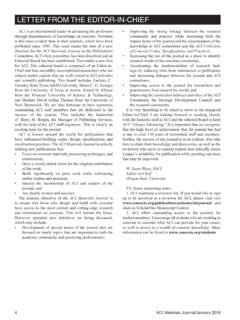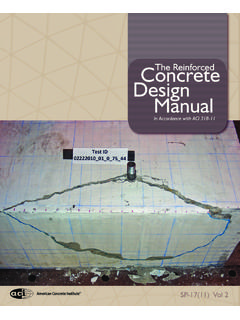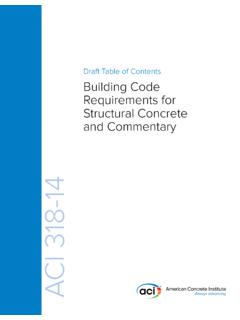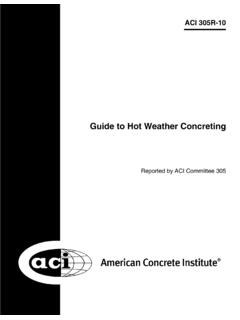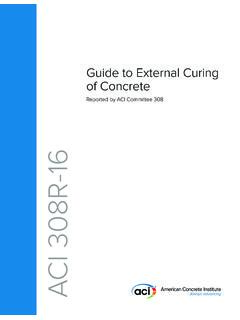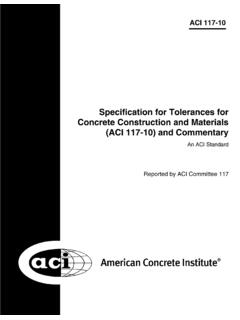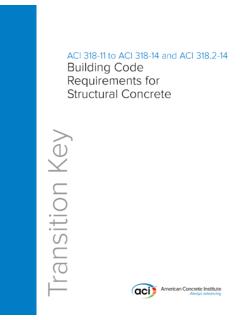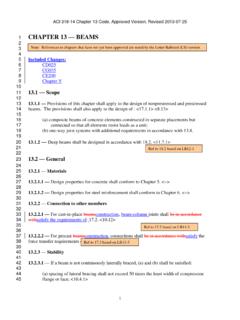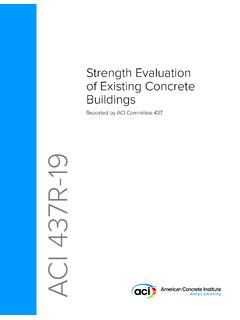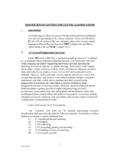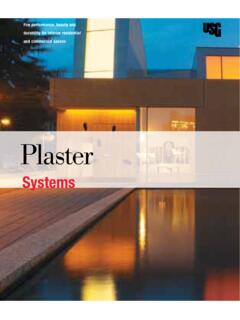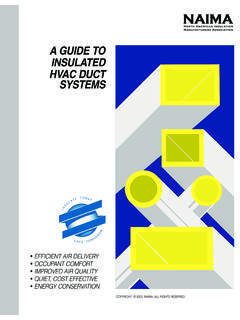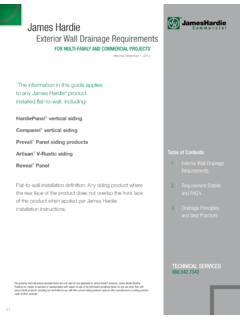Transcription of Structural CONCRETE REPAIR Crack Repair by APPLICATION ...
1 American CONCRETE Institute Advancing CONCRETE knowledgeACI RAP Bulletin 1 Structural Crack REPAIR by Epoxy Injection (ACI RAP-1)1 StructuralCrack REPAIR byEpoxy InjectionFIELD GUIDE TOCONCRETE REPAIRAPPLICATION PROCEDURES2 REPAIR APPLICATION Procedures BulletinStructural Crack REPAIR by Epoxy Injection (ACI RAP-1)3 Field Guide to CONCRETE REPAIR APPLICATION ProceduresStructural Crack REPAIR by Epoxy InjectionReported by ACI Committee E706 ACI RAP Bulletin 1(Reapproved 2009)J. Christopher BallH. Peter GolterJohn S. LundGeorge I. TaylorFloyd E. Dimmick, JoyceRichard MontaniPatrick M. WatsonPeter H. EmmonsKenneth M. LozenJay H. PaulDavid W. WhitmoreTimothy R. W. Gillespie*Primary F.
2 Keane*ChairACI REPAIR APPLICATION Procedure 2003, American CONCRETE rights reserved including rights of reproduction and use in anyform or by any means, including the making of copies by any photo pro-cess, or by electronic or mechanical device, printed, written, or oral, orrecording for sound or visual reproduction or for use in any knowledgeretrieval system or device, unless permission in writing is obtained fromthe copyright proprietors. Printed in the United States of Institute is not responsible for the statements oropinions in its publications. Institute publications arenot able nor intended to supplant individual training,responsibility or judgment of the user, or the supplier ofthe information DisclaimerThis document is intended as a voluntary field guide forthe Owner, design professional, and CONCRETE REPAIR con-tractor.
3 It is not intended to relieve the user of this guideof responsibility for a proper condition assessment andstructural evaluation of existing conditions, and for thespecification of CONCRETE REPAIR methods, materials, orpractices by an experienced is the responsibility of the user of this document toestablish health and safety practices appropriate to the specificcircumstances involved with its use. ACI does not make anyrepresentations with regard to health and safety issues and the useof this document. The user must determine the applicability ofall regulatory limitations before applying the document andmust comply with all applicable laws and regulations,including but not limited to, United States OccupationalSafety and Health Administration (OSHA) health andsafety APPLICATION Procedures BulletinIntroductionCertain things in life are inevitable.
4 Some are said toinclude death, taxes, and CONCRETE cracks! The latter issubject to volumes of literature on causes and cures. Some ofthe more typical causes for CONCRETE cracking include: Drying shrinkage; Thermal contraction or expansion; Settlement; Lack of appropriate control joints; Overload conditions that produce flexural, tensile, orshear cracks in CONCRETE ; and Restraint of movementOne of the potentially effective REPAIR procedures is toinject epoxy under pressure into the cracks. The injectionprocedure will vary, subject to the APPLICATION and locationof the Crack (s), with horizontal, vertical, and overheadcracks requiring somewhat different approaches.
5 Theapproach used must also consider accessibility to the crackedsurface and the size of the can be injected from one or both sides of a concretemember. If access is limited to only one side, installationprocedures may include variations in epoxy viscosities,injection equipment, injection pressure, and port spacing toensure full penetration of epoxy into the on the specific requirements of the job, crackrepair by epoxy injection can restore Structural integrity andreduce moisture penetration through CONCRETE cracks in.( mm) in width and greater. However, before anyconcrete REPAIR is carried out, the cause of the damage mustbe assessed and corrected and the objective of the repairunderstood.
6 If the Crack is subject to subsequent movement,an epoxy REPAIR may not be : Horizontal cracks of sufficient width can be filledby gravity-fed epoxies where suitable for the REPAIR (SeeCrack REPAIR by Gravity Feed with Resin, RAP-2).What is the purpose of this REPAIR ?The primary objective for this type of REPAIR is to restorethe Structural integrity and the resistance to moisture pene-tration of the CONCRETE do I use this method?Injection is typically used on horizontal, vertical, and over-head cracks where conventional REPAIR methods cannot pene-trate and deliver the specific REPAIR product into the to proceeding with a Crack REPAIR by epoxy injection,the cause of the Crack and the need for a Structural repairmust be determined.
7 If the Crack does not compromise thestructural integrity of the structure, injection with polyure-thane grouts or other nonstructural materials may be a moresuitable choice to fill the Crack . When a Structural REPAIR isrequired, conditions that cause the Crack must be correctedprior to proceeding with the epoxy injection. If the Crack isdamp and cannot be dried out, an epoxy tolerant to moistureshould be considered. Cracks caused by corroding reinforcingsteel should not be repaired by epoxy injection becausecontinuing corrosion will cause new cracks to do I prepare the surface? (see Fig. 1)Clean the surface area about 1/2 in. (13 mm) wide on eachside of the Crack .
8 This is done to ensure that materials usedto seal the top of the Crack (the cap seal) will bond properlyto the CONCRETE . Wire brushing is recommended becausemechanical grinders may fill the cracks with unwanted can also be removed by high-pressure water, oil-free compressed air, or power vacuums. When usingwater to clean out the Crack , blow out the Crack with oil-free,compressed or heated air to accelerate drying. Otherwise,allow enough time for natural drying to occur beforeinjecting moisture-sensitive CONCRETE surfaces adjacent to the Crack are deterio-rated, V -groove the Crack until sound CONCRETE is reached. V grooves can also be used when high injection pressuresrequire a stronger cap do I select the right material?
9 The appropriate viscosity of the epoxy will depend on thecrack size, thickness of the CONCRETE section, and injectionaccess. For Crack widths in. ( mm) or smaller, use alow-viscosity epoxy (500 cps or less). For wider cracks, orwhere injection access is limited to one side, a medium to gelviscosity material may be more suitable. ASTM C 881, Standard Specification for Epoxy-Resin-Base Bonding Systems for CONCRETE , identifies the basiccriteria for selecting the grade and class of epoxies (seeTable 1).For CONCRETE sections greater than 12 in. (305 mm), theworking time may need to be increased, and the viscositydecreased, as the Crack gets smaller.
10 In addition to the criteria used in Table 1 for epoxy selec-tion, the following product characteristics may also have tobe considered: Modulus of elasticity (rigidity); Working life; Moisture tolerance; Color; and Compressive, flexural, and tensile 1 Cracks must be clean and free of Crack REPAIR by Epoxy Injection (ACI RAP-1)5 What equipment do I need?Equipment for epoxy injection by high-pressure or low-pressure systems includes: Air guns; Hand-actuated delivery systems; Spring-actuated capsules; and Balloon-actuated the delivery method that will best suit the repairrequirements by considering the size and complexity of theinjection REPAIR and the economic limitations of the are the safety considerations?

